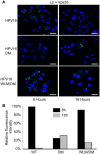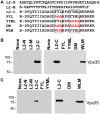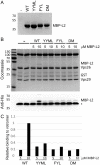Direct binding of retromer to human papillomavirus type 16 minor capsid protein L2 mediates endosome exit during viral infection
- PMID: 25693203
- PMCID: PMC4334968
- DOI: 10.1371/journal.ppat.1004699
Direct binding of retromer to human papillomavirus type 16 minor capsid protein L2 mediates endosome exit during viral infection
Abstract
Trafficking of human papillomaviruses to the Golgi apparatus during virus entry requires retromer, an endosomal coat protein complex that mediates the vesicular transport of cellular transmembrane proteins from the endosome to the Golgi apparatus or the plasma membrane. Here we show that the HPV16 L2 minor capsid protein is a retromer cargo, even though L2 is not a transmembrane protein. We show that direct binding of retromer to a conserved sequence in the carboxy-terminus of L2 is required for exit of L2 from the early endosome and delivery to the trans-Golgi network during virus entry. This binding site is different from known retromer binding motifs and can be replaced by a sorting signal from a cellular retromer cargo. Thus, HPV16 is an unconventional particulate retromer cargo, and retromer binding initiates retrograde transport of viral components from the endosome to the trans-Golgi network during virus entry. We propose that the carboxy-terminal segment of L2 protein protrudes through the endosomal membrane and is accessed by retromer in the cytoplasm.
Conflict of interest statement
The authors have declared that no competing interests exist.
Figures







Similar articles
-
A Novel PDZ Domain Interaction Mediates the Binding between Human Papillomavirus 16 L2 and Sorting Nexin 27 and Modulates Virion Trafficking.J Virol. 2015 Oct;89(20):10145-55. doi: 10.1128/JVI.01499-15. Epub 2015 Jul 22. J Virol. 2015. PMID: 26202251 Free PMC article.
-
Vesicular trafficking of incoming human papillomavirus 16 to the Golgi apparatus and endoplasmic reticulum requires γ-secretase activity.mBio. 2014 Sep 16;5(5):e01777-14. doi: 10.1128/mBio.01777-14. mBio. 2014. PMID: 25227470 Free PMC article.
-
Cell-Penetrating Peptide Mediates Intracellular Membrane Passage of Human Papillomavirus L2 Protein to Trigger Retrograde Trafficking.Cell. 2018 Sep 6;174(6):1465-1476.e13. doi: 10.1016/j.cell.2018.07.031. Epub 2018 Aug 16. Cell. 2018. PMID: 30122350 Free PMC article.
-
L2, the minor capsid protein of papillomavirus.Virology. 2013 Oct;445(1-2):175-86. doi: 10.1016/j.virol.2013.04.017. Epub 2013 May 17. Virology. 2013. PMID: 23689062 Free PMC article. Review.
-
Papillomaviruses and Endocytic Trafficking.Int J Mol Sci. 2018 Sep 4;19(9):2619. doi: 10.3390/ijms19092619. Int J Mol Sci. 2018. PMID: 30181457 Free PMC article. Review.
Cited by
-
A Ran-binding protein facilitates nuclear import of human papillomavirus type 16.PLoS Pathog. 2021 May 11;17(5):e1009580. doi: 10.1371/journal.ppat.1009580. eCollection 2021 May. PLoS Pathog. 2021. PMID: 33974675 Free PMC article.
-
Human Papillomavirus Entry: Hiding in a Bubble.J Virol. 2016 Aug 26;90(18):8032-5. doi: 10.1128/JVI.01065-16. Print 2016 Sep 15. J Virol. 2016. PMID: 27412595 Free PMC article. Review.
-
Coevolutionary Analysis Implicates Toll-Like Receptor 9 in Papillomavirus Restriction.mBio. 2022 Apr 26;13(2):e0005422. doi: 10.1128/mbio.00054-22. Epub 2022 Mar 21. mBio. 2022. PMID: 35311536 Free PMC article.
-
The Interaction of Human Papillomavirus Infection and Prostaglandin E2 Signaling in Carcinogenesis: A Focus on Cervical Cancer Therapeutics.Cells. 2022 Aug 15;11(16):2528. doi: 10.3390/cells11162528. Cells. 2022. PMID: 36010605 Free PMC article. Review.
-
Traptamer screening: a new functional genomics approach to study virus entry and other cellular processes.FEBS J. 2022 Jan;289(2):355-362. doi: 10.1111/febs.15775. Epub 2021 May 8. FEBS J. 2022. PMID: 33604985 Free PMC article. Review.
References
-
- Parkin DM, Bray F (2006) Chapter 2: The burden of HPV-related cancers. Vaccine 24 Suppl 3: S3/11–25. - PubMed
-
- Liu WJ, Gissmann L, Sun XY, Kanjanahaluethai A, Muller M, et al. (1997) Sequence close to the N-terminus of L2 protein is displayed on the surface of bovine papillomavirus type 1 virions. Virology 227: 474–483. - PubMed
Publication types
MeSH terms
Substances
Grants and funding
LinkOut - more resources
Full Text Sources
Other Literature Sources
Molecular Biology Databases
Research Materials

